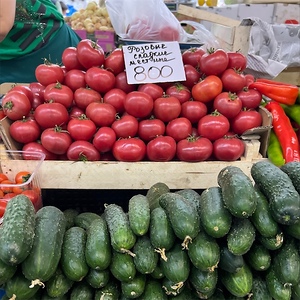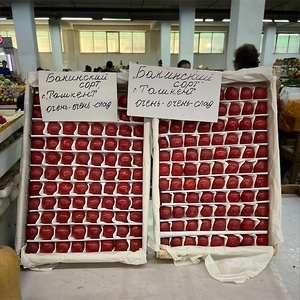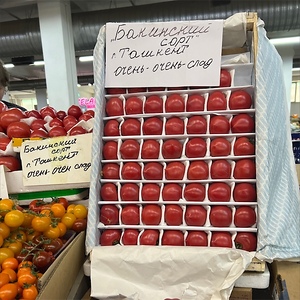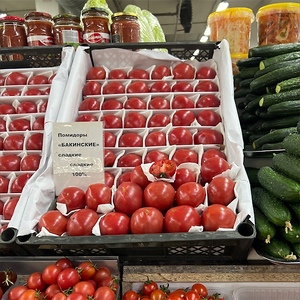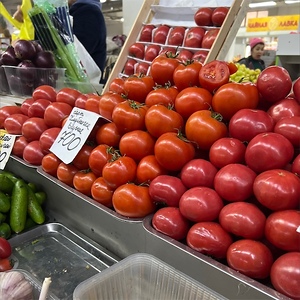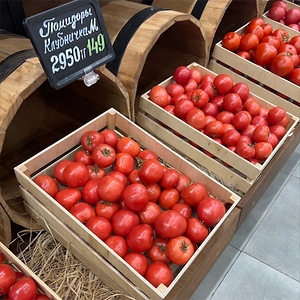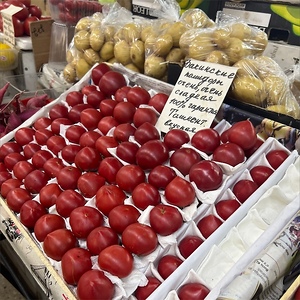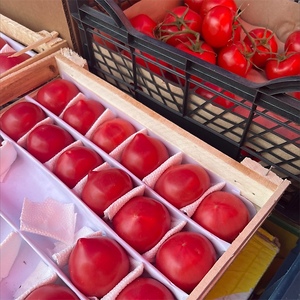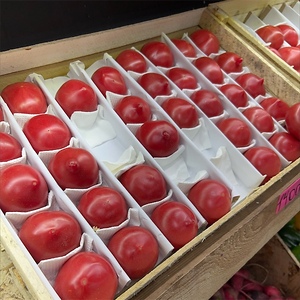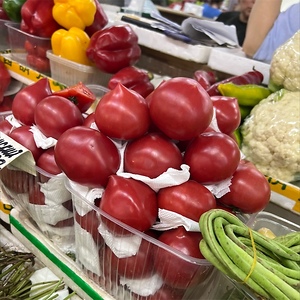

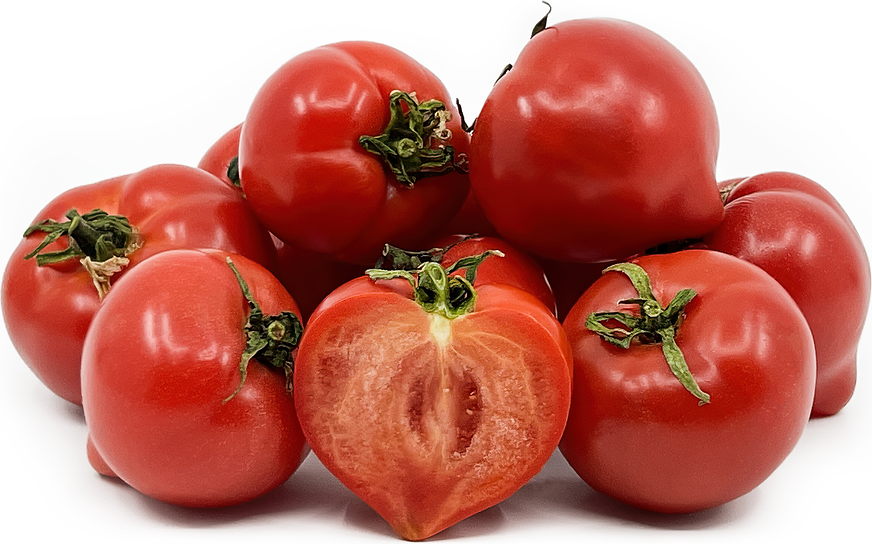
Strawberry Tomatoes
Estimated Inventory, lb : 0
Description/Taste
Strawberry tomatoes vary in size, depending on growing conditions, and are generally medium to large, averaging 120 to 160 grams in weight, sometimes reaching up to 250 grams. The variety is known for its distinct elongated shape, showcasing broad, curved shoulders tapering to a narrow, pointed tip. Strawberry tomatoes grow in hanging clusters of 6 to 8 fruits, and the skin is smooth, taut, semi-thick, and glossy, ripening from green to vibrant, bright red hues. The tomatoes are also capped with dark green, lanceolate-shaped leaves. Underneath the surface, the red flesh is dense, aqueous, and meaty with a succulent, tender consistency. The flesh also encases 2 to 4 chambers filled with a gelatinous liquid and tiny yellow or ivory seeds. Strawberry tomatoes release a rich aroma and are consumed raw when ripe. The skin and flesh are edible, contributing a sweet and savory taste with subtly sour nuances.
Seasons/Availability
Strawberry tomatoes are harvested in the summer through early fall when grown in open fields, with a peak season in July and August. In greenhouses, the variety is cultivated year-round.
Current Facts
Strawberry tomatoes, botanically classified as Solanum lycoperiscum, are a specialty variety belonging to the Solanaceae or nightshade family. The early to mid-season cultivar is an indeterminate variety, meaning the plants produce tomatoes throughout the entire growing season. It is important to note that multiple tomato varieties are generally labeled as Strawberry tomatoes. The two main types stem from Germany and Russia, and in Germany, there are large oxheart types and cocktail types named Strawberry tomatoes. Black and orange varieties have also been commercially released in Europe. In Russia, the Strawberry tomato variety is known as the Strawberry Tree tomato and is a large plant reaching up to two meters in height in greenhouses and 1.7 meters when grown in open fields. Approximately six clusters of tomatoes can grow from the plant's central stem, and Strawberry tomatoes are traditionally harvested 100 to 115 days after sowing. Strawberry tomatoes are known for their disease resistance, productivity, extended storage properties, and tolerance to temperature fluctuations and unfavorable growing conditions. When in season, Strawberry tomatoes are hand-picked by gently twisting from the vine, and consumers value the variety for their sweet, savory, aromatic taste. Strawberry tomatoes are versatile and utilized in a wide array of raw and cooked culinary preparations.
Nutritional Value
Strawberry tomatoes have not been extensively studied for their nutritional properties. Like other red tomato varieties, Strawberry tomatoes may be a source of lycopene, an antioxidant that helps to protect the overall health of the body and fight against free radicals, vitamin A to maintain healthy organ functioning, vitamin C to strengthen the immune system, and folate to develop DNA and RNA. Tomatoes also provide fiber to regulate the digestive tract, potassium to balance fluid levels within the body, iron to produce the protein hemoglobin for oxygen transport through the bloodstream, calcium to build strong bones and teeth, and other nutrients, including vitamin K and phosphorus.
Applications
Strawberry tomatoes have a sweet and savory taste suited for fresh and cooked preparations. The variety’s semi-thick skin allows it to be transported and stored for extended periods, and it helps support the heart shape of the flesh when sliced longitudinally. Strawberry tomatoes are popularly consumed out of hand and are often sprinkled with salt for enhanced flavoring. The tomatoes can also be cut and added to salads, chopped with fresh herbs as a side dish, layered into sandwiches, or placed on toast. Try incorporating Strawberry tomatoes into gazpacho or other soups and stews. The variety can also be cooked into sauces for pasta and risotto or roasted with garlic and herbs. In addition to sauces and soups, Strawberry tomatoes are breaded and fried, stuffed with grains and meats, or cooked and served as a topping over meat main dishes. They can also be pickled, canned, cooked into ketchup and jams, or pressed into tomato juice. While less common, the tomatoes can be dried for extended use. Strawberry tomatoes pair well with spices such as cinnamon, cumin, sumac, allspice, and nutmeg, herbs including cilantro, parsley, basil, oregano, and mint, nuts such as almonds, hazelnut, and pine, and aromatics including onions, garlic, and shallots. Whole, unwashed Strawberry tomatoes will keep for 1 to 3 weeks when stored in a cool, dry, and dark location at room temperature. Tomatoes can also be frozen whole or in pieces for extended use.
Ethnic/Cultural Info
The most popular Strawberry tomato variety in Russia is known as Strawberry Tree tomatoes in local markets. Historically, tomatoes grown in Siberia were chosen for their productive nature and ability to be preserved for use throughout the winter season. As breeding advanced and new cultivars were created that could withstand harsh and challenging growing environments, consumer preferences began changing surrounding tomatoes. Strawberry Tree tomatoes represent a new era of varieties chosen for their increased visual appeal. Strawberry Tree tomatoes were named for the fruit’s resemblance to strawberries in coloring and shape. The tomato’s broad, curving shoulders tapering to a distinct point give the tomatoes a heart-like shape, similar in appearance to strawberries, and the variety’s bright red skin also evokes the feeling of the aggregate fruit. Beyond its strawberry moniker, the variety has also earned its “tree” descriptor from the plant’s growth habit. Strawberry Tree tomato plants form from a thick, central trunk, and multiple clusters of vines with dark green, leafy foliage cascade from the central trunk, giving the bushy variety a tree-like appearance. The clusters of bright red fruits dangling from the trunk contribute dramatic visuals to home gardens, and gardeners value the variety for its striking, ornamental nature. Strawberry Tree tomatoes are grown for their flavor and culinary use, but they are also planted in home gardens as a variety to impress visitors visually.
Geography/History
Strawberry tomatoes are descendants of wild tomato species native to South America. Wild tomatoes spread naturally through animal droppings, animal seed dispersal, and human migration, expanding their range from South America into Central America and Mexico. In the early 16th century, Spanish conquistador Hernán Cortés encountered several types of tomatoes in the Aztec city of Tenochtitlan, now modern-day Mexico City, and carried the seeds back to Spain. The Spanish are thought to have encouraged the spread of tomatoes throughout Europe. Once in Europe, tomatoes expanded into Northern European and Central Asian regions, where various types of Strawberry tomatoes were created. Some varieties were developed in Germany in the 18th century and are related to oxheart tomatoes. In Siberia, another Strawberry tomato variety was bred by scientists at the Siberian Garden Agricultural Company. This variety was released in the early 21st century, included in the Russian State Register in 2013, and was part of their commercially released series, "Sibiriada.” Today, Strawberry tomatoes are primarily found in Europe and Central Asia and are grown in open fields in regions with long, warm summers and in greenhouses. The tomatoes are sold through local markets and specialty distributors.



